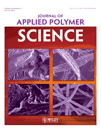Synthesis and characterization of poly(hydroxamic acid)–poly(amidoxime) chelating ligands from polymer-grafted acacia cellulose
Abstract
Graft copolymerization of methyl acrylate (MA) and acrylonitrile (AN) onto acacia cellulose was carried out using free radical initiating process in which ceric ammonium nitrate (CAN) was used as an initiator. The optimum grafting yield was determined by the certain amount of acacia cellulose (AGU), mineral acid (H2SO4), CAN, MA, and AN at 0.062, 0.120, 0.016, 0.397, and 0.550 mol L−1, respectively. The poly(methyl acrylate-co-acrylonitrile)-grafted acacia cellulose was obtained at 55°C after 2-h stirring, and purified acrylic polymer-grafted cellulose was characterized by FTIR and TG analysis. Therein, the ester and nitrile functional groups of the grafted copolymers were reacted with hydroxylamine solution for conversion into the hydroxamic acid and amidoxime ligands. The chelating behavior of the prepared ligands toward some metal ions was investigated using batch technique. The metal ions sorption capacities of the ligands were pH dependent, and the sorption capacity toward the metal ions was in the following order: Zn2+ > Fe3+ > Cr3+ > Cu2+ > Ni2+. © 2011 Wiley Periodicals, Inc. J Appl Polym Sci, 2011




